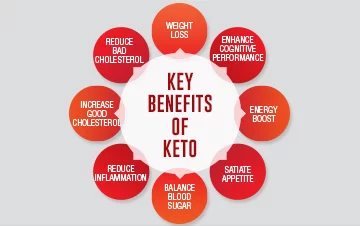How Does The Ketogenic Diet Work?
The ketogenic diet is made possible by forcing the body into a state of ketosis. This occurs due to eating a very low amount of carbohydrates and eating a very high amount of fat-rich foods. Instead of using glucose from the carbohydrates, the body will now move to using the high amount of fat stored in the body for energy. This diet is often used by people to help them lose weight.
Unfortunately, the keto diet may only provide weight loss for a short period of time. More research needs to be done to see if there are any benefits over a long period of time.
It is, however, noteworthy that this diet was first used in children with epilepsy, as it helps reduce the onset of seizures.
The Metabolic Process Known As Ketosis
As mentioned above, the body initially uses glucose as the primary source of energy. When the body does not have enough stored glucose for energy, it starts to burn the stored fat instead. In turn, it builds up acid in the body called ketones. These ketones are then used for energy to fuel the body. This metabolic process is known as ketosis.
Ketones are found in the bloodstream and are removed from the body through urinating. If small amounts are found in the urine, it indicates that the body is breaking down fat, which is normal, however, if there are high levels of ketones in the urine, it may poison the body, leading to a process called ketoacidosis.
In conclusion, ketosis is a metabolic state whereby the body converts stored fat into energy, which in turn releases ketones.
Can Ketosis Be Beneficial For Diabetic Patients?
The Ketogenic Diet has been recommended to patients with Type 2 Diabetes to ensure that they have a sufficient fuel supply from the high-fat intake. This is because there is usually not enough insulin to process the glucose.
However, diabetic patients need to monitor their ketone levels as ketoacidosis may occur due to high concentrations in their urine. Furthermore, a ketogenic diet comes with unwanted problems such as nausea, excessive thirst and hunger, fatigue, and headaches. If you have diabetes, you will not want to struggle with all these possible side effects and risks.
What Is Diabetic Ketoacidosis?
Diabetic ketoacidosis usually occurs when the body is not able to produce enough insulin to break down glucose. This problem, as well as the ketogenic diet, in turn, causes the body to start breaking down fat for energy. The burning of this fat produces ketones. Excess amounts can cause a buildup in the bloodstream. This is known as diabetic ketoacidosis (DKA).
Persons with type 1 diabetes do not produce insulin, thus they are at a higher risk of getting DKA. However, one can also trigger DKA through stress, surgery, physical or emotional trauma, and drug abuse.
Symptoms of ketoacidosis include:
- Pain in the tummy
- Breath that smells fruity
- Fatigue and confusion
- Constant thirst
- Nausea
- Throwing up
- Frequent need to urinate
- Having a hard time breathing
How To Prevent Ketoacidosis
Ketosis may occur in persons with a low intake of carbohydrates, women who are pregnant, extended periods of exercise, or in patients with diabetes. Diabetic patients who get ketoacidosis may fall into a diabetic coma or even die. Treatment is usually administered by healthcare workers, and followed by hospitalization.
To prevent ketoacidosis, diabetic patients can do the following:
- Frequently monitor blood sugar levels
- Drink enough water and replace electrolytes as needed
- Use correct insulin dosage as needed
- Follow a diabetic treatment plan
- Test ketone levels with a home urine test kit
Do you want to find an effective Keto treatment? Check out our top rated Keto products












